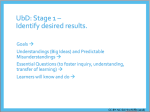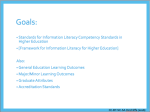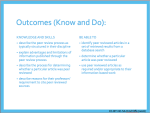In its first action on the ACRL Framework for Information Literacy for Higher Education, the ACRL Board stated that “we have accepted the Framework and it will assume its place among the constellation of documents used by information literacy practitioners” (http://www.acrl.ala.org/acrlinsider/archives/9814).
That metaphorical framing – constellation – stuck with me and over the past year I’ve been using it to explore ways to bring together and work productively with both the ACRL Information Literacy Competency Standards and the Framework (as well as the many other information literacy policy documents that the ACRL Board has adopted over the years, including the Characteristics of Programs of Information Literacy that Illustrate Best Practices: A Guideline, the Standards for Proficiencies for Instruction Librarians and Coordinators, and the various subject and other specialty information literacy standards).
I have found the constellation metaphor to be very evocative. What does it mean for stars to be in a constellation? If we think about the night sky, we never see all of the constellations clearly. There are stars, and by drawing connections among those stars and imagining what they might be symbolize, we bring different images into focus. As the earth rotates and the seasons change, the constellations that are visible to us change; so, there are aspects of positionality and relativeness when we think about constellations.
I believe the constellation metaphor is helping us see that it’s a matter of bringing a perspective to the information literacy documents and seeing which of them are in brighter relief for us at a given point in time and which are most useful for us to move our programs forward at that point in time. Doing so will create the shapes or the images that we see and determine which needs to shine brightest in our situation, while at the same time aligning our local circumstances with national “sky” – the systems of articulation, transfer, and accreditation that concern our institutions and thus our libraries.
As the keynote speaker for the Pennsylvania Consortium for the Liberal Arts “Implementing the New Framework for Information Literacy for Higher Education at PCLA Libraries” Conference and in a session at the 15th Annual Illinois Information Literacy Summit, I had the opportunity to lead librarians through a process of exploring the constellation metaphor. It is truly amazing how many different constellations are discussed – from Pleiades to the Big Dipper – and each time participants also went a step further, unprompted, to bring in both the North Star and the Milky Way as additional metaphors.
 At the most basic application of the metaphor, I personally have come to see the Framework and Standards through the lens of the constellation Gemini. The two documents are not identical, though they share a common touchpoint (the goal of bringing students to a state of information literacy). They each have their own shape, size, and components but we can recognize them as related. The fact that one exists does not diminish the other and the fact that they “hold hands” helps each bring the other into focus.
At the most basic application of the metaphor, I personally have come to see the Framework and Standards through the lens of the constellation Gemini. The two documents are not identical, though they share a common touchpoint (the goal of bringing students to a state of information literacy). They each have their own shape, size, and components but we can recognize them as related. The fact that one exists does not diminish the other and the fact that they “hold hands” helps each bring the other into focus.
If I’m sharing this in a conversation, this is the point where someone usually says something like “okay Lisa, that’s great, but what does it mean practically?” Good question because as librarians we’re practitioners so we need the pragmatic!
So, pragmatically, let me share how I’ve come to understand the Framework and the Standards working together. Since the Framework itself says that the frames present concepts and not learning outcomes, I see that the frames as helping us develop the pathways of student learning, the journey.
But, a journey needs a destination; we still need something else that we’re teaching towards. That is to say, we need the answer to the question “what will an information literate student be able to do?” That is the value of the Standards. The Standards set a destination. We may interpret the language of the Standards into our local dialect (as many libraries have done with the Standards over the past 15 years), but we can always map that local to the national because we have the shared language of the destination in the Standards.
Interestingly, as I have worked with this understanding, I have found it very easy to bring both the Standards and the Framework into my instructional design practice, which is heavily influenced by Understanding by Design (I identified a number of short introductions to this method for the PCLA conference mentioned above and they are linked from the conference materials). As I say often, with the Framework and Standards, it doesn’t have to be either/or, it can be both/and.
I’ll end this blog post with an excerpt of four slides from the PCLA keynote that show what it looks like to design a single class instruction session using the both/and approach to the Framework and the Standards through the Understanding by Design approach to instructional design. (I will admit that I’ve simplified here a bit because an information literacy instructional design should be put in the context of campus general education learning outcomes, major/minor program outcomes, etc. as well. I couldn’t work all that into a keynote though it is included in the one-day workshop that I give on information literacy instructional design.)
P.S. My gratitude to an academic library director whose background is information literacy practice and who holds an important high-level leadership position in ACRL (but who also asked to not be publically identified) for encouraging me to share how I’ve been approaching this. That director has heard from many librarians asking for practical guidance/training on how to use the Framework for instructional practice while still responding to the reality that their institutions require that their information literacy programs to have a set of standard learning outcomes for purposes of assessment, accreditation, and program evaluation. Or, to put it more bluntly, how to be creative practitioners in the classroom while also ensuring that our information literacy programs, and by extension our libraries, can be defended and justified in this “neoliberal” era.




2 thoughts on “The ACRL Information Literacy Constellation”